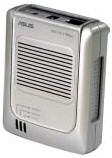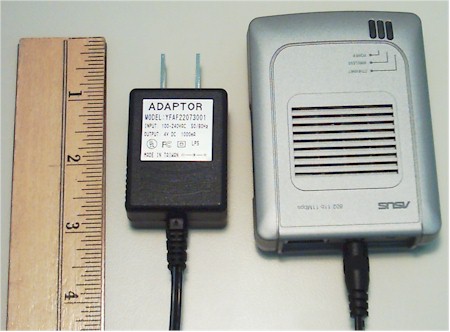ASUS WL-330 Pocket Wireless Access Point reviewed
At first glance, you might dismiss ASUS' tiny WL-330 as a wireless toy, but you'd be wrong. This mighty-mite packs good performance, WDS bridging / repeating and Ethernet-to-wireless adapter capabilities into a package that's sure to lend itself to some creative uses.
Introduction

| ASUS Pocket Wireless Access Point | |
|---|---|
| Summary | Teeny 802.11b access point based on Marvell chipset. Supports WDS-based repeating and can be used as client adapter. |
| Update | 1/19/2005 - ASUS says it was in error. Neither WPA nor WPA-PSK is now or will be supported. They are concentrating efforts on 802.11g products. 9/23/2004 - V2.04 firmware adds WPA support 2/24/2004 - USB cable is now included |
| Pros | • Extremely small and portable • Good performance • Can run as an AP or Ethernet client adapter • WDS-based bridging / repeating |
| Cons | • Very limited monitoring features • Can't attach higher-gain antennas |
Though you might think there's no interest or innovation left in the 802.11b market, ASUS seems out to prove otherwise. Its WL-330 Pocket Wireless Access Point may not win points for exciting styling, but it's packed with features that should prove very useful to wireless LAN builders.
Basic Features
The WL-330 is a dual-function product. In one mode, it's an 802.11b access point that supports WDS-based wireless bridging and repeating. But when you flip a switch it functions as an 802.11b to Ethernet adapter that supports both AdHoc and Infrastructure operation. It doesn't however, support routing, so can't be used to wirelessly share an Internet connection all by itself (hey, what do you want for $69?).
I thought Buffalo Technology's WLA2-G54 [reviewed here] was the smallest-available AP I'd seen (and it is the smallest 802.11g AP), but the 330 moves the bar a little lower. This is one of those products that you have to hold in your own hand to appreciate how small it really is, but Figure 1 is intended to give you some basis for comparison.

Figure 1: The AP with appropriately tiny power supply.
For some reason, the WL330's case reminds me of an electric shaver, but it's thoughfully designed. It has ventilation slots on the top - which is good because it gets fairly warm in operation - along with Power and Wireless and Ethernet link / activity LEDs which are bright enough to be seen at a distance.
The AP / Adaptor switch, ventilation holes, a keyhole slot for wall mounting and four rubber feet are on the bottom. The power and 10/100 Ethernet jack are on one end, along with a button that provides Reset-to-factory-defaults in AP mode and AP scanning in Adaptor mode. Note that the Ethernet connector is auto MDI / MDI-X, which means that it will connect up to whatever you plug it into using either a normal or crossover Ethernet UTP cable.
By the way, ASUS provides a nice little carry case for the 330, its power supply and other assorted odds and ends, which I thought was a nice touch!
Sign up to get the BEST of Tom's Guide direct to your inbox.
Get instant access to breaking news, the hottest reviews, great deals and helpful tips.
Current page: ASUS WL-330 Pocket Wireless Access Point reviewed
Next Page Construction DetailsTom's Guide upgrades your life by helping you decide what products to buy, finding the best deals and showing you how to get the most out of them and solving problems as they arise. Tom's Guide is here to help you accomplish your goals, find great products without the hassle, get the best deals, discover things others don’t want you to know and save time when problems arise. Visit the About Tom's Guide page for more information and to find out how we test products.
